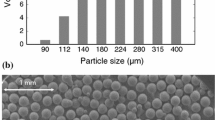Conclusions
-
1.
We discovered that the principles of concentration-time analogy and of analogy to the parameter f (specific surface of the particles of filler) can be applied to describe the diagrams of short-term creep and to predict long-term creep of polyester resins with different concentration and dispersity of the filler (cement). It was experimentally established that the greater the dispersity of the filler is, the larger is the function of concentration-time reduction.
-
2.
Modeling and calculation of the strain properties of a composite according to the properties of the structural components showed that around the particles of filler there may exist an interfacial film whose rigidity is poorer than the rigidity of the matrix, and the thickness decreases with increasing phase boundary in the composite. In that case damage may cumulate under conditions of creep of the composite.
Similar content being viewed by others
References
L. Monette and M. P. Anderson, “The Young's modulus of silica beads/epoxy composites. Experiments & simulations,” J. Appl. Phys.,75, No. 3, 1442–1455 (1994).
V. P. Selyaev, V. I. Solomatov, and V. T. Erofeev, Composite Building Materials with Carcass Structure [in Russian], Saransk (1993).
Yu. S. Lipatov, V. F. Babich, and N. I. Korzhuk, “The existence of superposition frequency-concentration of filler in polymers with filler,” Vysokomolekulyarnye Soedineniya, Seriya A,14, No. 7, 1629–1635 (1974).
Yu. Khristova and K. Aniskevich, “Prediction of creek of cured epoxy resin filled with marble flour,” Mekh. Kompozitnykh Materialov,30, No. 5, 590–599 (1994).
R. Christensen, Introduction to the Mechanics of Composites [Russian translation], Moscow (1982).
E. P. Honig, P. E. Wierenga, and J. H. M. van der Linden, “Theory of elastic behavior of composite materials,” J. Appl. Phys.,62, No. 5, 1610–1612 (1987).
Yu. A. Dzenis, Prediction of the Characteristics of the Viscoelastic Properties and of Thermal Expansion of Polymer Composites with Hybrid Granular-Fibrous Filler, PhD Thesis, Riga (1989).
J. Simeonov and Yu. Khristova, Polymer Concrete [in Bulgarian], Sofia (1980).
S. M. Perlin and G. V. Makarov, The Chemical Resistance of Glass Reinforced Plastics [in Russian], Khimiya, Moscow (1983).
S. T. Nagai and I. M. Robinson, “Tensile dilatometric studies of deformation in polymetric materials and their composites,” J. Materials Sci.,28, No. 6, 1421–1429 (1993).
Author information
Authors and Affiliations
Additional information
Translated from Mekhanika Kompozitnykh Materialov, Vol. 31, No. 2, pp. 179–185, March–April, 1995.
Rights and permissions
About this article
Cite this article
Aniskevich, K., Khristova, Y. Influence of the concentration and dispersity of the filler on the creep of polymer composite. Mech Compos Mater 31, 126–130 (1995). https://doi.org/10.1007/BF00616279
Received:
Issue Date:
DOI: https://doi.org/10.1007/BF00616279




